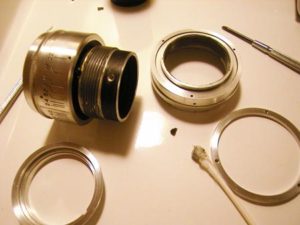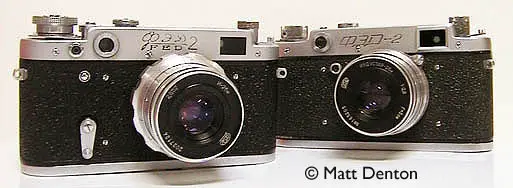- Produced 1955-1970 FED, Kharkov, Ukraine
- Film type 135 (35mm)
- Picture size 24 x 36mm
- Weight 1lb, 4.7oz (586.8g) with Industar-26M
- Lens coated LTM 39mm Industar-26M 52mm 1:2.8-22 (4 elements, 3 groups)
- Filter size 40.5mm
- Focal range 1m to infinity
- Viewfinder coupled rangefinder
- Exposure meter none
- Shutter double cloth curtain
- Shutter speeds B, 1/25-1/500
- Diopter correction lever
- Self-timer on some versions
- Accessory shoe and PC sync connection
Overview
I knew as soon as I had made a decision to buy a FED 3 that a FED 2 was in my future. I just loved the look of it, the wide base, the rugged assuredness it seemed to carry in its well-honed design. Then I had to have another, I liked it so much. Plus the first, the 2C, wasn’t in the greatest shape — it smells quite musty from the damp and has paint loss all over its army green body. Works great, though — a testament to its hardiness!

It was obviously well-used by the Kazakstani who scratched his or her name (and country of origin) in the leather case once upon a time. I made up for it by getting a de-lovely FED 2E:

Notice the different wind knob on the 2E, a major ergonomic improvement, and the PC connection is on the top cap rather than on the body. Also the lens is a slightly different design, though still designated Industar-26M and retaining the same Tessar 4/3 optical formula. Both are lovely and very sharp. Other differences abound — to wit, there are so many flavors of the FED 2 with tiny little model year variations that you could collect just them, or FEDs as a whole, and be happy as a clam. So be careful you don’t get addicted like me and some other people I know!
I won’t delve too deeply into the somewhat sordid history of the FED. Suffice it to say that the FED factory in Kharkov was an orphanage-turned-work-commune named for Felix E. Dzerzhinsky, founder of the original Soviet Secret Police. It’s a very interestsing story, and you can read all about it and more on this excellent page, just make sure to come back when you’re done (I love that site!).
My own contribution to that story – I handed my 2C to an old Russian man who rides my bus, and his eyes lit up as he told me how it was a ‘historical camera’ and mentioned the former KGB, and how the FED factory was populated with criminals. ‘Dis kammera, et vwas dessined and bilt by krriminals, you know?’ So maybe the orphanage thing was only part of the story. No telling how much propaganda fed the perception of this camera’s history. I say this because of another Russian woman’s strong opinion (whispered to me with a certain secretive confidence) that “FEDs are good cameras! Those Zorkis and Kievs, they are garbage.” OK, I nodded. Now, I know they’re not but what a touchstone these FEDs seem to be for expatriates!
The FED 2 feels great in the hands, it’s nicely balanced and compact, with a comfortable vulcanite exterior and a smooth, snappy shutter (a little softer and smoother on the 2e than the 2c). Very similar in feel to the slightly bulkier Zorki-4 but the viewfinder on the Zorki is astoundingly large in comparison. One of my favorite and least favorite parts of the FED 2 as well as the Zorki is the diopter adjustment lever which is nice to have but easy to get stuck fiddling with if you know what I mean.
Tips & Tricks
As with most of these FSU rangefinders and any camera where winding on also causes the film speed selector to turn, ALWAYS cock the shutter before changing shutter speeds! Changing film speeds without tensioning the shutter can damage the shutter, or at the very least make it temporarily erratic.
Though this and the other FEDs and Zorkis have LTM (Leica Thread Mount) lenses which should be interchangable with each other and with the several available auxiliary lenses (which require matching auxiliary viewfinders if different from 50mm), there are slight variations in mounts that may give you unpredictable results if you don’t match the lens to the camera. LTM is similar to M42 in that a whole-lens cam means the register marks don’t need to line up perfectly straight up for the lens to focus properly, but your mileage may vary if you switch lenses that aren’t matched to the (FED) camera. See this site for more info on lens-to-film distance and rangefinder adjustment.
SPEAKING of lenses, I’ve found that these old Industars are packed with a grease that thickens to a wax-like consistency after several decades, so if you plan to use it a lot you might want to disassemble, clean, and re-lube your Industar with some light synthetic grease. This is not a task for the faint of heart, but definitely worth the trouble — these little Industars are some of the best lenses I’ve ever used. To make the task easier since it seems to be a common need, I’ve put together a tutorial!

Related Links
- My special page devoted to relubing Industar-26 and Industar-61 lenses
- I have the English manual on my Manuals page, thanks to a kind reader named Michael Frangos
- Jim Blazik’s marvelous sub-site on the Fabulous FED 2
- Which is part of this wonderful Soviet-era rangefinder site
- Mirror of the new, great FED & Zorki survival site by Jay
- Another page devoted to Russian Rangefinders
- And a nice page on ‘Why Russian Leica Copies?’ Well, because!
